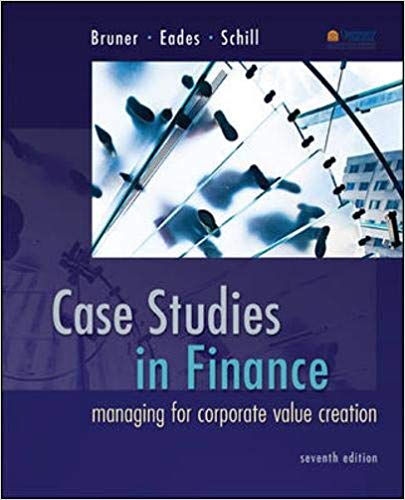Question
CASE STUDY NO. 03 (Chapter 04 by R. Glenn Hubbard) Will a Black Swan Eat Your 401(k)? If you go to work for a medium-size
CASE STUDY NO. 03 (Chapter 04 by R. Glenn Hubbard)
Will a Black Swan Eat Your 401(k)?
If you go to work for a medium-size or large company, one of the benefits is likely to be a
company-sponsored 401(k) retirement plan. Established under a law passed by Congress in 1978, these plans allow you to save for retirement by investing part of your salary in financial assetstypically mutual funds that buy stocks and bonds. You don't pay taxes on the funds you contribute to your 401(k) plan or on earnings on the funds if you don't withdraw them until after you reach retirement age.
In choosing among the options that most firms provide, you will want to take into account both
the expected return and the level of risk. As we have just seen, in financial markets there is a tradeoff between risk and return, with the riskiest assets typically having the highest expected returns.
The following table provides data from 1926 to 2015 on four financial assets that are widely owned by investors. The "small" companies in the table are only small in the context of the U.S. stock market. In fact, they are fairly large, with the total value of their shares of stock being between $300 million and $2 billion. The "large" companies include General Motors, AT&T, McDonald's,
Apple, and the other 500 firms included in the S&P 500, which is an average of the stock prices of firms valued at more than $5 billion. The average annual return is the simple average of the 89 yearly returns for each of the four assets during this period. Risk is measured as the volatility of the annual returns and is calculated as the standard deviation of each asset's annual returns during this period.
The data in the second and third columns of the table illustrate the trade-off between risk and
return. Investors in stocks of small companies during these years experienced the highest average returns but also accepted the most risk. Investors in U.S. Treasury bills experienced the lowest average returns but also faced the least risk.
Financial Asset
Average Annual Rate of Return
12.0%
Risk
23.0%
Small Company Stocks
10.0%
Large Company Stocks
17.4%
Long-term Treasury
5.6%
bonds
12.2%
U.S Treasury bills
3.4%
3.4%
The conventional measure of risk used in the table indicates the range within which returns
typically fluctuate. Sometimes, though, returns occur that are far outside the usual range of returns.
For instance, during 2008, at the height of the financial crisis, investors in large company stocks suffered a 37% loss. The probability of such a large loss was less than 5%. Stocks performed so poorly because the collapse of the housing market set off a financial crisis and the worst recession since the Great Depression of the 1930s. Nassim Nicholas Taleb, a professional investor and professor of economics at New York University, has popularized the term black swan event to
refer to rare events that have a large effect on society or the economy. The name comes from the fact that Europeans believed that all swans were whiteuntil 1697, when black swans were
discovered in Australia. So, a black swan event is surprising and contrary to previous experience.
Some economists see the financial crisis as a black swan event because before it occurred, few believed it was possible.
During 2008, the value of the average 401(k) account declined from $65,500 to $45,500, or by more than 30%. As a result, many risk-averse individual investors shifted the funds in their
retirement accounts out of stock mutual funds and into bond mutual funds or even money market funds, which were paying interest rates of 1% or less. For people who had already retired or who were close to retirement, a decline of more than 30% in the value of their 401(k) accounts could be devastating if they were counting on those funds to finance their living expenses during retirement. But for younger investors, the problems caused by the decline were less severe. In fact, the value of large company stocks had regained their 2008 level by 2013.
So, the black swan of the financial crisis may have done more damage to the average investor's portfolio by causing a shift to less riskybut lower returnassets than by the temporary decline in stock prices it caused.
Answer the following Questions:
The following is from a column on marketwatch.com: "There are lots of things we more or less
know will happen.... But what are the potential black swans?"
a. What does the columnist mean by a "black swan"?
b. Is it likely that there is a good answer to the columnist's question? Briefly explain.
Step by Step Solution
There are 3 Steps involved in it
Step: 1

Get Instant Access to Expert-Tailored Solutions
See step-by-step solutions with expert insights and AI powered tools for academic success
Step: 2

Step: 3

Ace Your Homework with AI
Get the answers you need in no time with our AI-driven, step-by-step assistance
Get Started


